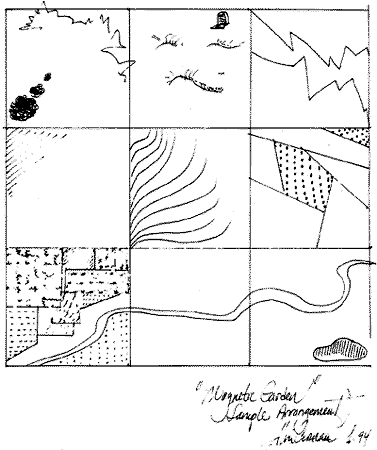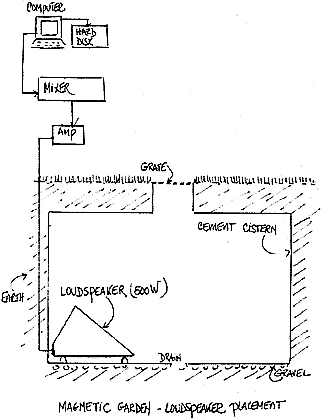| ALVIN CURRAN MUSIC FROM THE CENTER OF THE EARTH II the magnetic garden II THE MAGNETIC GARDEN "The melody, first thought terminal, is recycled on a child's buzz saw but then reappears as a Mensch. Ten minutes later it turns up as a 5/4 Waltz scrutinized by a group of unemployed harmonica players in the center of Darmstadt. It then visits Persia, Buffalo and Irene coming to rest on a bed of one note hymns in Braxton's former studio - a rim-shot away from the Grand Canal... this is Motorola landscape design; this is Sonic Geography ..."7 THE MAGNETIC GARDEN in concept is a fusion between my 1973 solo-performance piece SONGS AND VIEWS OF THE MAGNETIC GARDEN8 and NOTES FROM UNDERGROUND just described. But here the word "garden" no longer means the invisible iron particles distributed on a spool of 1/4 inch tape, but a real garden where planted things grow, and in this instance a place where land arts and sonic arts meet in a special way. While many of my environmental works have been typically ephemeral, having a duration of some 30-60 minutes and often presented as a one-time event, the MAGNETIC GARDEN is distinctly a physical entity - a piece of land artistically transformed and sonically enhanced - in fact no different from any other kind of public or privately commissioned earth work or environmental sculpture. From my present perspective THE MAGNETIC GARDEN is for me the single "locus" where I bring together my years of continuous research in music, technology and plants. Though animated by my fundamental idea, the GARDEN is, above all, a collaborative forum and as such will be presented as the collective work of a selected group of artists, computer scientists and creative gardeners. The artist's independently created landscape designs (on equal sized plots) will be arranged by mutual agreement and these, in turn, united by my own underground sound installations threaded unseen throughout the whole. Since this work is by definition an open and flexible proposal, its ultimate configurations are variable, dependent both on the dimensions of the chosen site, the number of participating artists,9 their technical needs, and the general budget. While there are presently no artists' designs to present, I can only offer here a humble musician's sketch - a hypothetical model designed by me, intended to illustrate a certain simplicity and variety, my fanciful drawing, is here seen from an imaginary over-head view. |
 |
In this model the GARDEN is a size-able quadrangle consisting of from nine to sixteen equal-sized plots 125-200m.sq. each, specially designed in plantings, earth patterns, and inorganic materials by a selected group of artists. Each plot, however created, will house at its center, an underground loudspeaker system, installed in a cement (cistern-like) chamber, partially open to the ground above through an unobtrusive iron grate. |
 |
The musical signals arriving at the loudspeakers will be selected by a specially "composed" computer program in conjunction with midi-mixers (appendix), which will determine: to what loudspeaker or sequence of speakers, for what duration, at what relative loudness and with what degree of transformation these musical sounds will be heard. The music, then, composed of a vast and diverse quantity of raw sampled sounds, will be heard in constantly changing patterns and cycles as it emerges from one or more points in the garden's loudspeaker configuration. This will be further enhanced by rich directional and velocity patterns applied to the sound's movements. The key to the music, however, will be a unique program which will emulate in tandem with the above mentioned sound movements, the constant but slow patterns of change within the year's four seasons. Hence, the system's essential sounds will not be cast in static or fixed sequences but in dynamic states of cyclical change over long periods of time. Unlike a typical botanical garden, this work will avoid the encyclopedic and didactic and will concentrate on the metaphysical, the fantastic and the everyday. For here, inside this musical earthwork, unlike in a concert hall or art gallery, the public has no convenient ritual to hide behind; they must create their own "texts" and "scores" from the images, sounds and movements as they move through them. Not mere figures in a landscape, the viewers/listeners play an active role in this open theater - simply by being there and moving within it. Visually, one could imagine areas designed in sand, stone, wood, metals, water, viscous fluids, enterred videos, found objects and neon as well as plots of common herbs, thickets of fruit-bearing vines, mounds of ornamental grasses, stands of bamboo, beds of pumpkins, plants suspended in the air, sculpted bushes, vast carpets of Rauolia Hookeri and other creative cultivations - whatever the local climate, terrain and native flora might or might not suggest within reason. Technically, a computer system for multi-channel digital audio mixing, playback, processing and routing will be the entire musical production center. And the music, primarily heard from underground speakers, may be additionally diffused from speakers placed above-ground in trees, shrubs or in other natural locations such as rock piles, hay-stacks, wells, or mounds of earth etc. Sounds appearing at any speaker location in the garden may be moved to any other in whatever direction and at any audible speed. The music, conceptually quite simple, is none the less com-positionally very complex, consisting of multiple strata of fixed and indeterminate structures in constantly shifting relationships which take place over short and very long periods of time. Governing each layer's fundamental elements of duration, speed, density, timbre loudness, and spatial configurations, there will be two main groups of algorithms: one which acts on the micro time structures (events measured in seconds to a few minutes) and one which governs the macro time dimension of hours, days, months and years. The latter is to be, in effect, a sonic analogue of biological time. Excluding the use of mechanically produced sounds (windmills, waterwheels, high tension wires etc) all others used in this work will be stored as raw materials on a 1 to 2 Gigabyte Hard Disk. The following is a paritial list of their categories and nature: HUMAN LANGUAGES: Khosa (click language), Basque, Lakota etc. The voices of John Cage, Mahatma Gandhi, Maryanne Amacher, Eric Satie, Rosa Luxemburg, Giacinto Scelsi, Groucho Marx, Kurt Schwitters, Elijah Mohammed, Marlene Dietrich, Duchamp, The Lone Ranger, Mao Tse Tung, Marilyn Monroe etc.... ANIMAL VOCALIZATIONS: Buffalo mating, millions of bats swarming from a Texas cave; drum fish, Arctic wolves, the interior of bee hives, Canadian loons, Venezuelan tree frogs, north American elk bugling etc., gorilla calls; mating prarie chickens and elephant sub-audio frequencies etc. .... COMMON HUMAN ACTIVITIES FROM ANYWHERE: Walking down a country road in Java; making love in Paris; the Fourth of July in Little Italy/Chinatown NYC; ice-floes in the Arctic seas; World-Cup soccer game in Italy; giving birth in Mexico City; The l917 Russian revolution; a room full of snoring people in Bombay; a horse festival in Ulan Bator ; a refugee camp in Africa; a wedding in Thailand etc. MUSICS FROM ANYWHERE: Rumanian gypsies; David Tudor's "Rainforest;" Inuit women's throat singing; Lamonte Young; Eastern European Jewish cantors; Pygmy children singing; Fanny Mendelssohn's Trio op.ll; Thelonius Monk; Om Khalsoum; Tibetan monks chanting; Conlon Nancarrow; Spike Jones; Yoko Ono, Souza, Fats Waller; the Musica Elettronica Viva group, Korean Court music, Berber women's Songs, Early Blue Grass, Hildegard von Bingen, Anthony Braxton, Wysznagradski, Queen Latifah, Theramin, Carl Stallings, Billie Holiday, Lakota Indians, Ethiopian Jews, Dr Dre etc. INDUSTRIAL/ENVIRONMENTAL SOUNDS: demolitions; pile drivers, ship horns; fog Horns; trains coupling; slaughter houses; thunder; marble quarries; volcanoes , Rome by night, Calcutta street festival, pubs in Dublin, homeless in Berkeley, children playing in Sarejevo; diamond mining in South Africa, massage parlours in Bangkok; tribal celebrations in the Brazilian rain forest. etc.... OTHER SOURCES could include COMMON AND RARE MUSIC INSTRUMENTS: dijeridoo, virginal, Sho, zither, Alpenhorn, Bandoneon, toy piano, contrabass saxophone, corrugated tubes; DIRECT RADIO and LIVE SOURCES: Via short-wave radio with computer accessible tunings; and where possible, direct telephone-line sends from nearby sound sites; or WIND, SOLAR or other MECHANICALLY DRIVEN INSTRUMENTS ... Footnotes 7. Liner notes for SCHTYX, op. cit. 8. The 1973 remastered recording released on CD, CATALYST/BMG, Fall l993 9. Some artists I would be interested in working with are: Agnes Denes, Mel Chin, Anna Murch, Melissa Gould, Joan Jonas, Nam June Paik, Robert Long etc. |
[TOP]